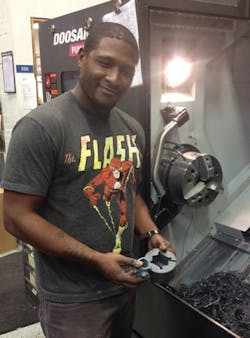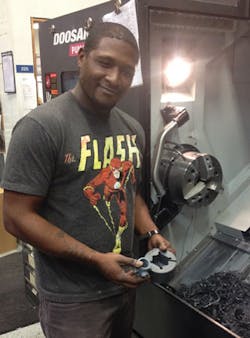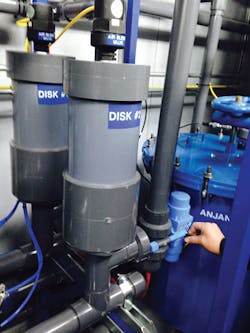Imagine the most severe service applications for waste treatment. Earthquakes, hurricanes, floods, and military operations will probably top the list. Add in the nasty ingredients found in those situations, and you’ve got a recipe for some of the harshest waste treatment imaginable. That’s where you’ll usually find Enviremedial Services Inc., an Oceanside, California, manufacturer of water purification systems designed to deliver potable water in the most miserable of circumstances.
That’s also where you’ll find sludge, mud, rotting materials and all sorts of detritus that can foul a piping system in no time, according to Geoffrey Keogh, president of Enviremedial Services. Valves required to control treatment pressure and flow are especially susceptible to fouling, and ultimately prone to failure when heavy particulates are present.
“When you deliver a purification system to desperate tsunami victims on the other side of the globe, you can’t risk failure,” explained Keogh.
A Torqued Tradition
Valve manufacturers have traditionally handled particulate issues by using high-pressure/high-torque actuators to overcome the sludge. These types of valves often use linear actuators with a screw-type mechanism and high compressive force to open and close valves. Unfortunately this incredibly high force traps debris in the valve seat and orifice, and routinely crushes the contaminants into those sealing surfaces. Once too much debris is crushed into the seat and orifice of the valve, the valve no longer seals properly, and is soon damaged beyond repair.
In situations such as the debris-filled tsunami flooding that Enviremedial equipment encountered in Sri Lanka and Japan, valve failure could occur in just a few actuations. Constant vigilance, cleaning, and service were required, resulting in unfortunate downtime for these critical systems.
Enviremedial engineers were continually seeking and testing alternative valves to solve these issues. Of the vast variety of valves on the market today, including gate valves, needle valves, butterfly valves, globe pattern valves, plug valves, and ball valves, the task of sealing with contaminated media is typically handled poorly or not at all. A valve suitable for contaminated media would ideally have highly polished sealing surfaces and tight fitting tolerances, which would enable the valve to push debris away and seal in spite of the media contaminants. The tolerances required for such parts typically result in much higher costs, which tend to be prohibitive in today’s commodity-oriented industrial marketplace.
Ball Valves’ Bad Reputation
During the search for better valving, Keogh said they’d heard about a robust ‘engineered’ ball valve by Plast-O-Matic. But ball valves are not traditionally associated with debris-laden liquid processing. The typical ball valve actuates with a 90-degree rotation and is loosely assembled with non-critical tolerances, inherent to metal casting or plastic molding. To make the valve work in spite of those tolerances, manufacturers typically use elastomeric O-ring seals that will compensate for voids and uneven surfaces.
Another problem inherent to most ball valve designs is that the ball is engaged at the top only, which allows some unintended movement at the bottom of the ball. This results in uneven wear to both the orifice and ball, and ultimately allows debris to lodge underneath the seals and cause premature failure.
The Trunnion Difference
For these reasons, the Enviremedial team wasn’t certain the Plast-O-Matic ball valve would be the best choice for their application but considered the corrosion-resistant material advantageous and proceeded with testing. The difference in the Plast-O-Matic offering turned out to be a combination of key features unique among thermoplastic valves: Trunnion design, and a super smooth, mirror-polished ball, all manufactured to extremely tight tolerances.
Trunnion design means that the ball is held at the top and the bottom. Unlike a ball that is held at the top only, the trunnion engagement eliminates movement at the bottom of the ball due to process pressure or debris impact. Because of the tolerances and finish, the mirror-polished ball acts like a wiper on the seals, essentially cleaning the sealing surfaces at every actuation. These features combine to prevent uneven seat wear, eliminate particle entrapment, and allow the ball valve to work for extended periods of time in heavy debris and sludge. It also eliminates the need for excessively high torque, and the problems inherent to that type of actuator.
Based on successful trials in debris and sludge contaminated liquids, as well as a number of reference cases where Plast-O-Matic ball valves had been used successfully for many years, Enviremedial Services rewrote their valve specs around the Plast-O-Matic True Blue Ball Valves. Keogh said they’ve been very pleased with the results. “We’ve been using Plast-O-Matic ball valves and actuators for years with no failures at all,” he said. “We have approximately 150,000 cycles on many of their air-actuated valves and have yet to see problems.”
In spite of ball valves’ bad reputation for handling solids, Keogh said the Plast-O-Matic product has proven otherwise. “The valves and actuators are bulletproof, easy to maintain and very easy to rebuild,” he said. “We actually cracked one manual valve ball strictly from abuse on a sludge application. We took the valve apart - it was filled with mud. We cleaned it, glued the ball back together and it’s working flawlessly again!”
Considering the nasty stuff that Enviremedial Services’ equipment encounters, Keough said, “It’s a lot less stressful when you don’t have to worry about a valve failing 7,000 miles away.”
More WaterWorld Current Issue Articles
More WaterWorld Archives Issue Articles





